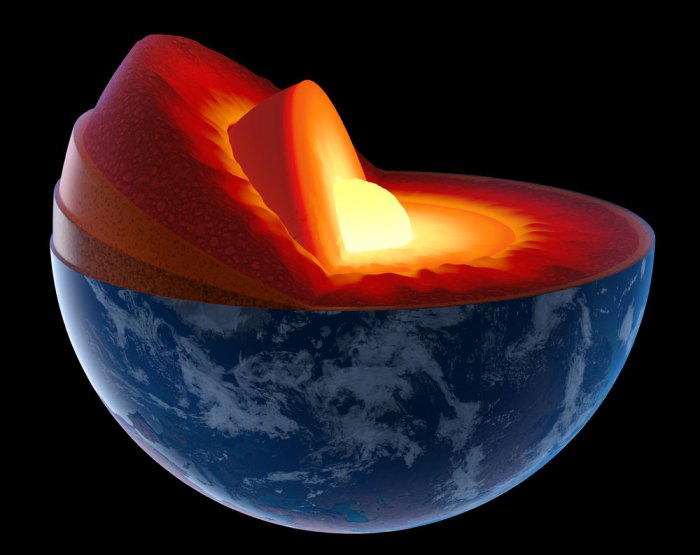Layer beneath the earth’s crust crossword – Delving into the enigmatic layer beneath the Earth’s crust, we embark on a journey to unravel its intricate composition, remarkable physical properties, and pivotal role in shaping our planet’s geological tapestry. From the depths of the mantle to the mysteries of the core, we uncover the secrets that lie beneath our feet.
Composed primarily of silicate rocks, this layer exhibits a dynamic range of physical properties. Its immense temperature gradient, increasing with depth, drives convection currents that power plate tectonics, shaping the Earth’s surface and influencing its geological evolution.
Layer beneath the Earth’s Crust

The layer beneath the Earth’s crust, known as the mantle, is a thick layer of rock that extends from the base of the crust to a depth of about 2,900 kilometers (1,800 miles). The mantle is composed primarily of silicate minerals, such as olivine, pyroxene, and garnet, and is much denser than the crust.
Physical Properties of the Mantle
The mantle is divided into two main layers: the upper mantle and the lower mantle. The upper mantle is more rigid and brittle than the lower mantle, and is characterized by the presence of seismic waves. The lower mantle is more fluid and plastic, and is characterized by the absence of seismic waves.
Role of the Mantle in Plate Tectonics, Layer beneath the earth’s crust crossword
The mantle plays a crucial role in plate tectonics. The movement of the mantle is driven by convection currents, which are caused by the heat from the Earth’s core. These convection currents cause the mantle to move in a circular pattern, which in turn causes the plates of the Earth’s crust to move.
Types of Rocks in the Mantle
The rocks in the mantle are primarily composed of silicate minerals, such as olivine, pyroxene, and garnet. However, there are also small amounts of other minerals, such as oxides and sulfides.
- Olivineis the most abundant mineral in the mantle. It is a green mineral that is composed of magnesium, iron, and silicon.
- Pyroxeneis the second most abundant mineral in the mantle. It is a black mineral that is composed of magnesium, iron, and silicon.
- Garnetis a red mineral that is composed of magnesium, aluminum, and silicon.
Distribution of Rock Types in the Mantle
The distribution of rock types in the mantle is not uniform. The upper mantle is dominated by olivine, while the lower mantle is dominated by pyroxene and garnet.
Geological Processes in the Mantle
The mantle is a dynamic region that is constantly being modified by geological processes. These processes include:
- Convection: Convection is the process by which heat is transferred from the Earth’s core to the surface. Convection currents in the mantle cause the plates of the Earth’s crust to move.
- Volcanism: Volcanism is the process by which magma from the mantle erupts onto the Earth’s surface. Volcanic eruptions can produce a variety of landforms, including mountains, volcanoes, and lava flows.
- Metamorphism: Metamorphism is the process by which rocks are changed by heat and pressure. Metamorphism can occur in the mantle when rocks are subjected to high temperatures and pressures.
Economic Importance of the Mantle
The mantle is a valuable source of a variety of minerals, including diamonds, gold, and platinum. These minerals are used in a variety of industrial and commercial applications.
- Diamondsare used in a variety of industrial applications, such as cutting tools and abrasives.
- Goldis used in a variety of jewelry and electronic applications.
- Platinumis used in a variety of catalytic converters and jewelry applications.
Exploration and Research in the Mantle
Exploring and studying the mantle is a challenging task. The mantle is located deep beneath the Earth’s surface, and it is extremely hot and dense. However, scientists have developed a variety of techniques to study the mantle, including:
- Seismic waves: Seismic waves are waves that travel through the Earth’s interior. Scientists can use seismic waves to study the structure and composition of the mantle.
- Drilling: Scientists have drilled deep into the Earth’s crust to collect samples of mantle rock. These samples can be used to study the composition and properties of the mantle.
- Geophysics: Geophysicists use a variety of techniques to study the Earth’s interior, including gravity measurements, magnetic measurements, and heat flow measurements.
Recent Advancements in Mantle Exploration and Research
In recent years, there have been a number of significant advancements in mantle exploration and research. These advancements include:
- The development of new seismic imaging techniques that have allowed scientists to create detailed images of the mantle.
- The drilling of the Kola Superdeep Borehole, which is the deepest hole ever drilled into the Earth’s crust. The Kola Superdeep Borehole has provided scientists with valuable information about the composition and properties of the mantle.
- The development of new geophysical techniques that have allowed scientists to study the mantle in greater detail.
Top FAQs: Layer Beneath The Earth’s Crust Crossword
What is the primary composition of the layer beneath the Earth’s crust?
The layer beneath the Earth’s crust is predominantly composed of silicate rocks.
How does the temperature gradient within the layer beneath the Earth’s crust contribute to plate tectonics?
The increasing temperature gradient with depth drives convection currents within the layer beneath the Earth’s crust, which in turn power plate tectonics.
What are some of the economically valuable resources found within the layer beneath the Earth’s crust?
The layer beneath the Earth’s crust contains valuable resources such as oil, gas, and various minerals.


